trailer TOYOTA MATRIX 2010 E140 / 2.G Owners Manual
[x] Cancel search | Manufacturer: TOYOTA, Model Year: 2010, Model line: MATRIX, Model: TOYOTA MATRIX 2010 E140 / 2.GPages: 448, PDF Size: 9.74 MB
Page 3 of 448

1
2
3
4
5
6
7
3
2-5. Driving information
Cargo and luggage ............. 147
Vehicle load limits ............... 150
Winter driving tips ............... 151
Trailer towing ...................... 155
Dinghy towing
(automatic
transmission) .................... 163
Dinghy towing
(manual transmission) ...... 164
3-1. Using the air conditioning
system and defogger
Air conditioning system ....... 168
Rear window and
outside rear view
mirror defoggers ............... 174
3-2. Using the audio system
Audio system types ............. 175
Using the radio .................... 178
Using the CD player ............ 184
Playing MP3 and WMA
discs.................................. 191
Optimal use of the audio
system .............................. 199
Using the AUX adapter ....... 202
Using the steering wheel
audio switches .................. 203
3-3. Using the hands-free phone
system (for cellular phone)
Hands-free phone system
(for cellular phone)
features ............................. 206Using the hands-free
phone system
(for cellular phone) ........... 209
Making a phone call ........... 218
Setting a cellular phone ...... 222
Security and system
setup ................................ 227
Using the phone book ........ 231
3-4. Using the interior lights
Interior lights list ................. 238
• Interior light ...................... 239
• Personal/interior lights...... 240
• Personal lights.................. 241
3-5. Using the storage features
List of storage features ....... 242
• Glove box ......................... 243
• Console box ..................... 243
• Cup holders ...................... 245
• Bottle holders ................... 247
• Auxiliary boxes ................. 248
3-6. Other interior features
Sun visors........................... 250
Vanity mirrors ..................... 251
Clock .................................. 252
Ashtrays ............................. 253
Cigarette lighter .................. 254
Power outlet ....................... 255
Grocery bag hook ............... 257
Seatback table.................... 259
Floor mat ............................ 260
Luggage compartment
feature .............................. 261
Compass ............................ 268
3Interior features
Page 101 of 448
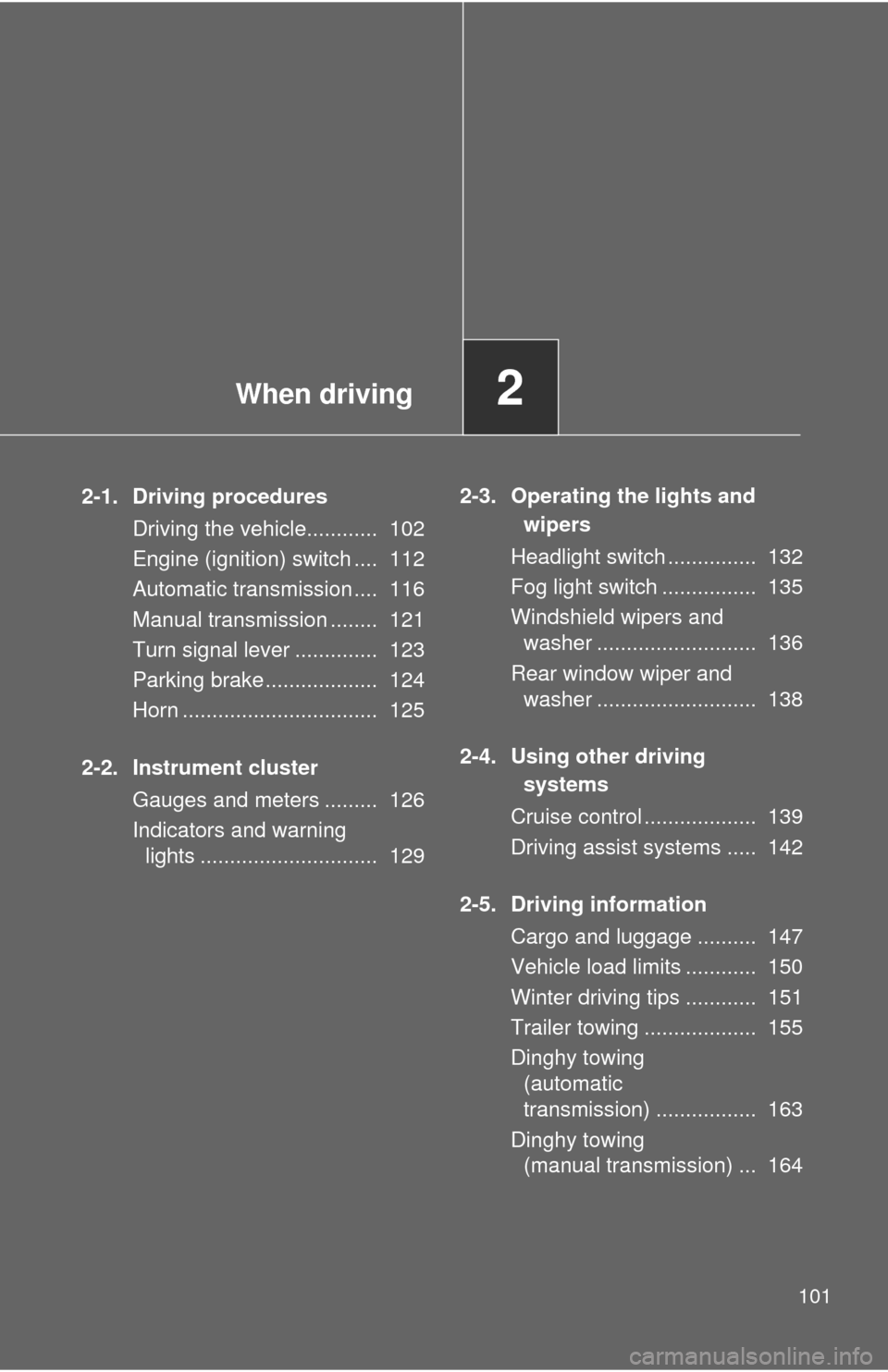
When driving2
101
2-1. Driving procedures
Driving the vehicle............ 102
Engine (ignition) switch .... 112
Automatic transmission .... 116
Manual transmission ........ 121
Turn signal lever .............. 123
Parking brake ................... 124
Horn ................................. 125
2-2. Instrument cluster
Gauges and meters ......... 126
Indicators and warning
lights .............................. 1292-3. Operating the lights and
wipers
Headlight switch ............... 132
Fog light switch ................ 135
Windshield wipers and
washer ........................... 136
Rear window wiper and
washer ........................... 138
2-4. Using other driving
systems
Cruise control ................... 139
Driving assist systems ..... 142
2-5. Driving information
Cargo and luggage .......... 147
Vehicle load limits ............ 150
Winter driving tips ............ 151
Trailer towing ................... 155
Dinghy towing
(automatic
transmission) ................. 163
Dinghy towing
(manual transmission) ... 164
Page 104 of 448
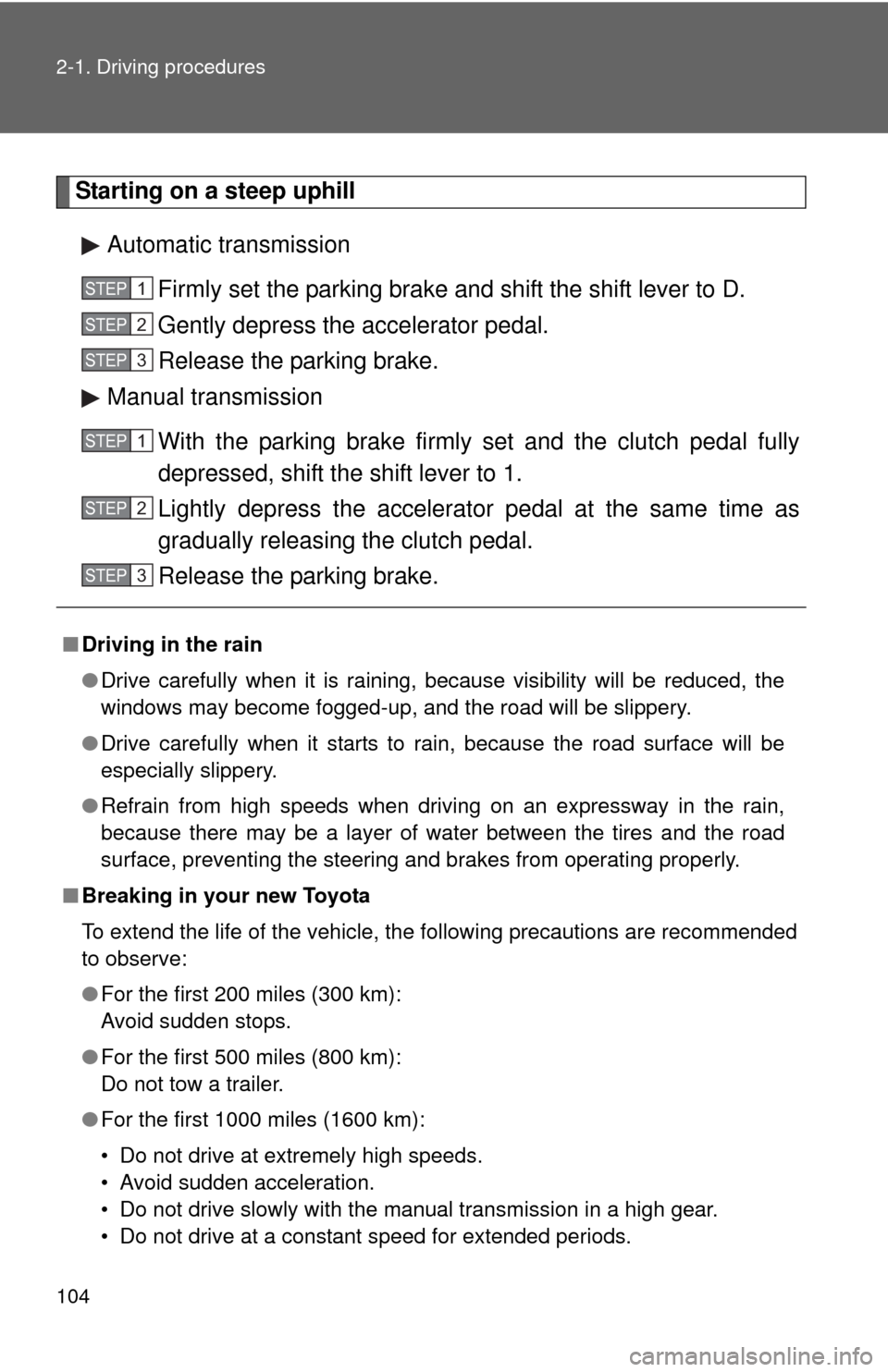
104 2-1. Driving procedures
Starting on a steep uphill
Automatic transmission
Firmly set the parking brake and shift the shift lever to D.
Gently depress the accelerator pedal.
Release the parking brake.
Manual transmission
With the parking brake firmly set and the clutch pedal fully
depressed, shift the shift lever to 1.
Lightly depress the accelerator pedal at the same time as
gradually releasing the clutch pedal.
Release the parking brake.
■Driving in the rain
●Drive carefully when it is raining, because visibility will be reduced, the
windows may become fogged-up, and the road will be slippery.
●Drive carefully when it starts to rain, because the road surface will be
especially slippery.
●Refrain from high speeds when driving on an expressway in the rain,
because there may be a layer of water between the tires and the road
surface, preventing the steering and brakes from operating properly.
■Breaking in your new Toyota
To extend the life of the vehicle, the following precautions are recommended
to observe:
●For the first 200 miles (300 km):
Avoid sudden stops.
●For the first 500 miles (800 km):
Do not tow a trailer.
●For the first 1000 miles (1600 km):
• Do not drive at extremely high speeds.
• Avoid sudden acceleration.
• Do not drive slowly with the manual transmission in a high gear.
• Do not drive at a constant speed for extended periods.
STEP1
STEP2
STEP3
STEP1
STEP2
STEP3
Page 141 of 448
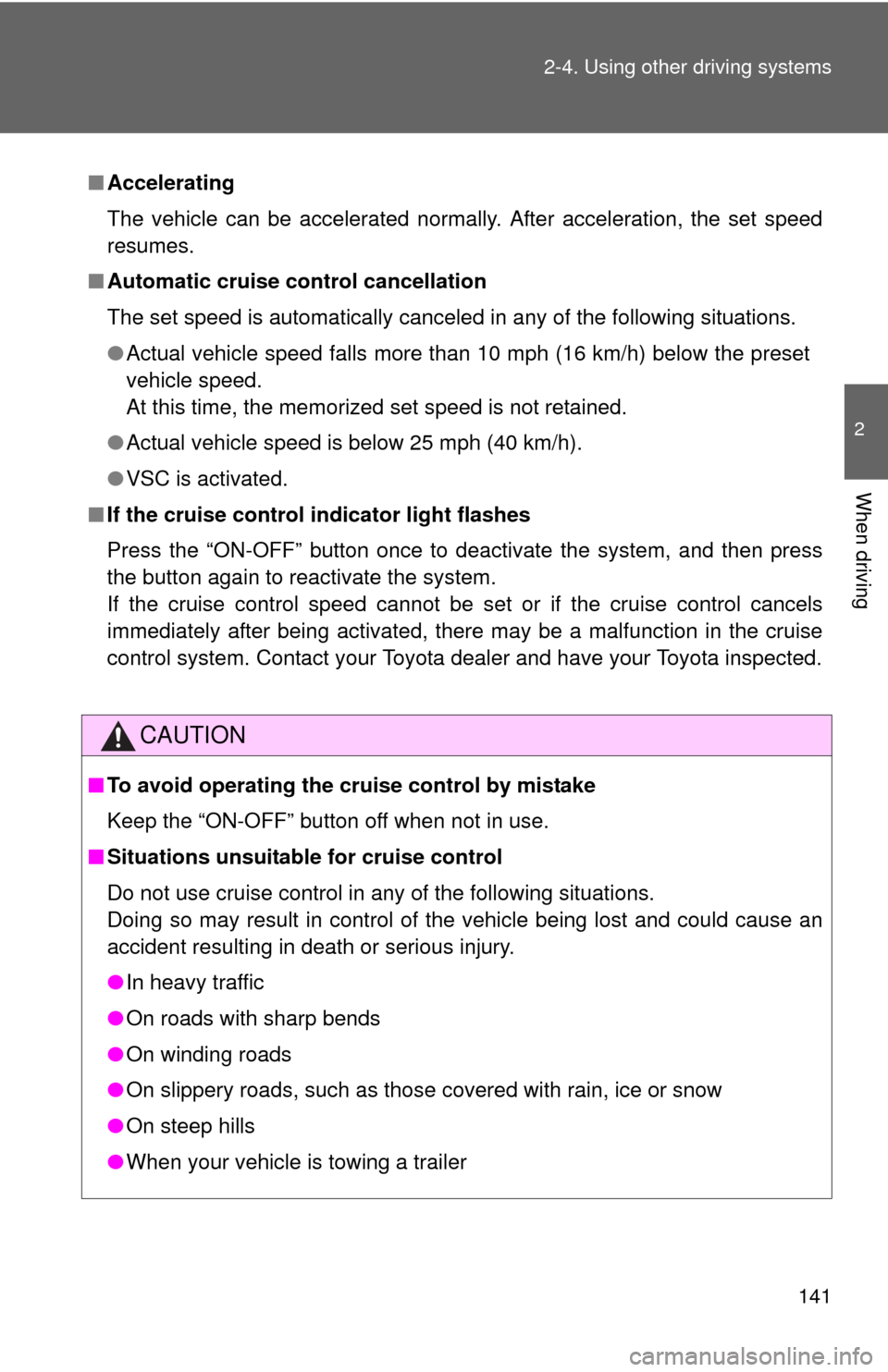
141 2-4. Using other driving systems
2
When driving
■Accelerating
The vehicle can be accelerated normally. After acceleration, the set speed
resumes.
■Automatic cruise control cancellation
The set speed is automatically canceled in any of the following situations.
●Actual vehicle speed falls more than 10 mph (16 km/h) below the preset
vehicle speed.
At this time, the memorized set speed is not retained.
●Actual vehicle speed is below 25 mph (40 km/h).
●VSC is activated.
■If the cruise control indicator light flashes
Press the “ON-OFF” button once to deactivate the system, and then press
the button again to reactivate the system.
If the cruise control speed cannot be set or if the cruise control cancels
immediately after being activated, there may be a malfunction in the cruise
control system. Contact your Toyota dealer and have your Toyota inspected.
CAUTION
■To avoid operating the cruise control by mistake
Keep the “ON-OFF” button off when not in use.
■Situations unsuitable for cruise control
Do not use cruise control in any of the following situations.
Doing so may result in control of the vehicle being lost and could cause an
accident resulting in death or serious injury.
●In heavy traffic
●On roads with sharp bends
●On winding roads
●On slippery roads, such as those covered with rain, ice or snow
●On steep hills
●When your vehicle is towing a trailer
Page 148 of 448
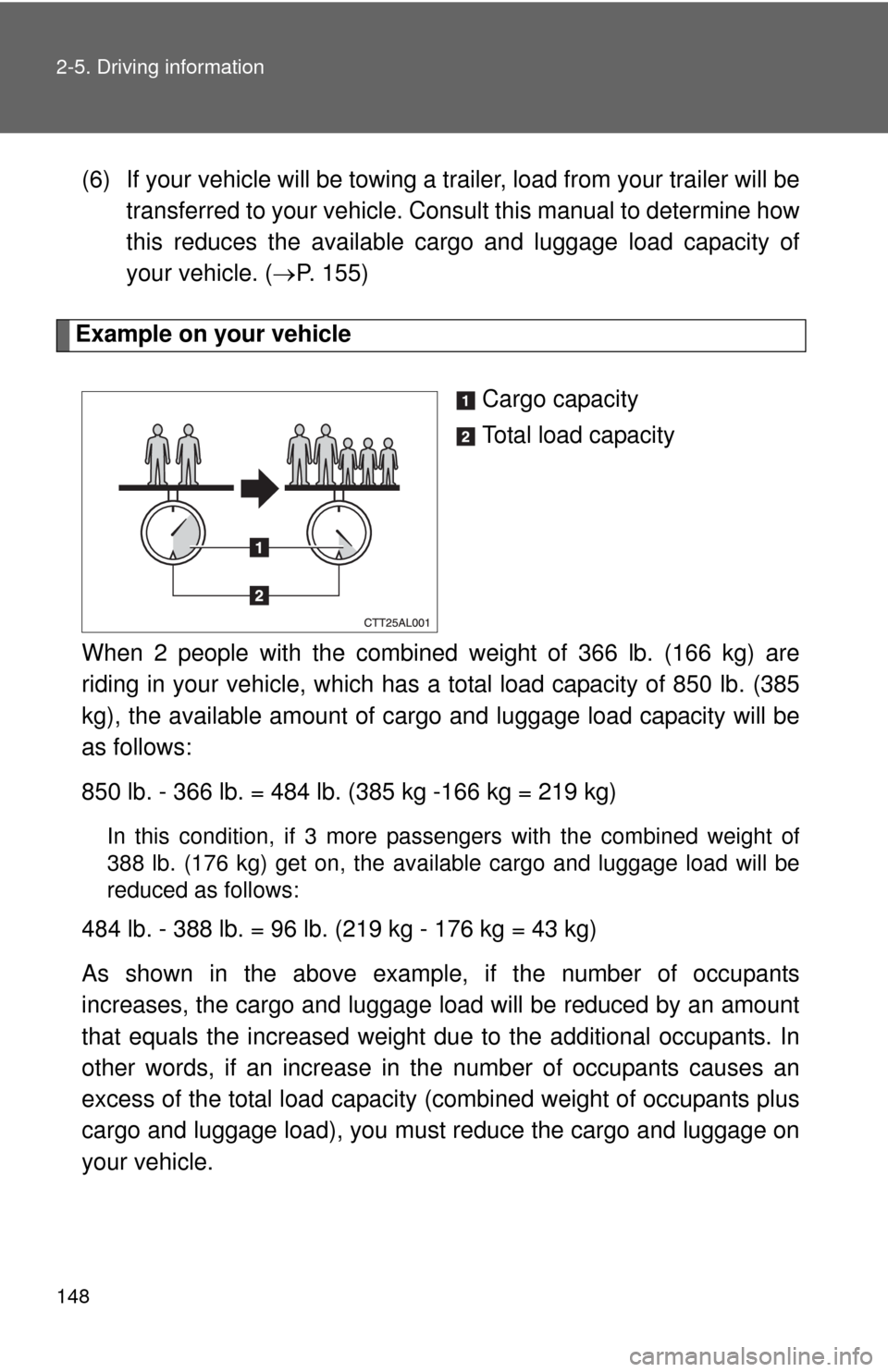
148 2-5. Driving information
(6) If your vehicle will be towing a trailer, load from your trailer will be
transferred to your vehicle. Consult this manual to determine how
this reduces the available cargo and luggage load capacity of
your vehicle. (P. 155)
Example on your vehicle
Cargo capacity
Total load capacity
When 2 people with the combined weight of 366 lb. (166 kg) are
riding in your vehicle, which has a total load capacity of 850 lb. (385
kg), the available amount of cargo and luggage load capacity will be
as follows:
850 lb. - 366 lb. = 484 lb. (385 kg -166 kg = 219 kg)
In this condition, if 3 more passengers with the combined weight of
388 lb. (176 kg) get on, the available cargo and luggage load will be
reduced as follows:
484 lb. - 388 lb. = 96 lb. (219 kg - 176 kg = 43 kg)
As shown in the above example, if the number of occupants
increases, the cargo and luggage load will be reduced by an amount
that equals the increased weight due to the additional occupants. In
other words, if an increase in the number of occupants causes an
excess of the total load capacity (combined weight of occupants plus
cargo and luggage load), you must reduce the cargo and luggage on
your vehicle.
Page 155 of 448
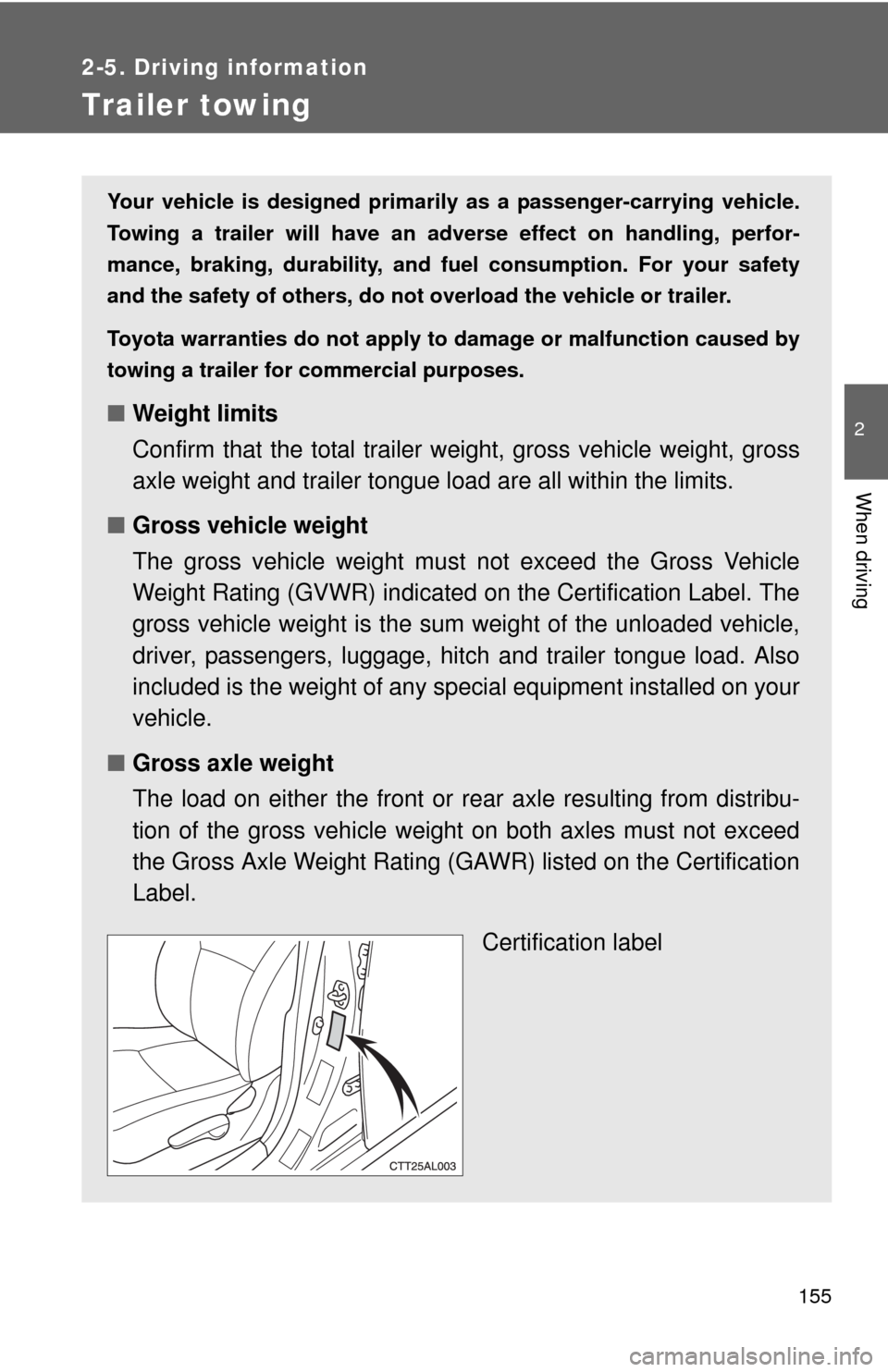
155
2-5. Driving information
2
When driving
Trailer towing
Your vehicle is designed primarily as a passenger-carrying vehicle.
Towing a trailer will have an adverse effect on handling, perfor-
mance, braking, durability, and fuel consumption. For your safety
and the safety of others, do not overload the vehicle or trailer.
Toyota warranties do not apply to damage or malfunction caused by
towing a trailer for commercial purposes.
■Weight limits
Confirm that the total trailer weight, gross vehicle weight, gross
axle weight and trailer tongue load are all within the limits.
■Gross vehicle weight
The gross vehicle weight must not exceed the Gross Vehicle
Weight Rating (GVWR) indicated on the Certification Label. The
gross vehicle weight is the sum weight of the unloaded vehicle,
driver, passengers, luggage, hitch and trailer tongue load. Also
included is the weight of any special equipment installed on your
vehicle.
■Gross axle weight
The load on either the front or rear axle resulting from distribu-
tion of the gross vehicle weight on both axles must not exceed
the Gross Axle Weight Rating (GAWR) listed on the Certification
Label.
Certification label
Page 156 of 448
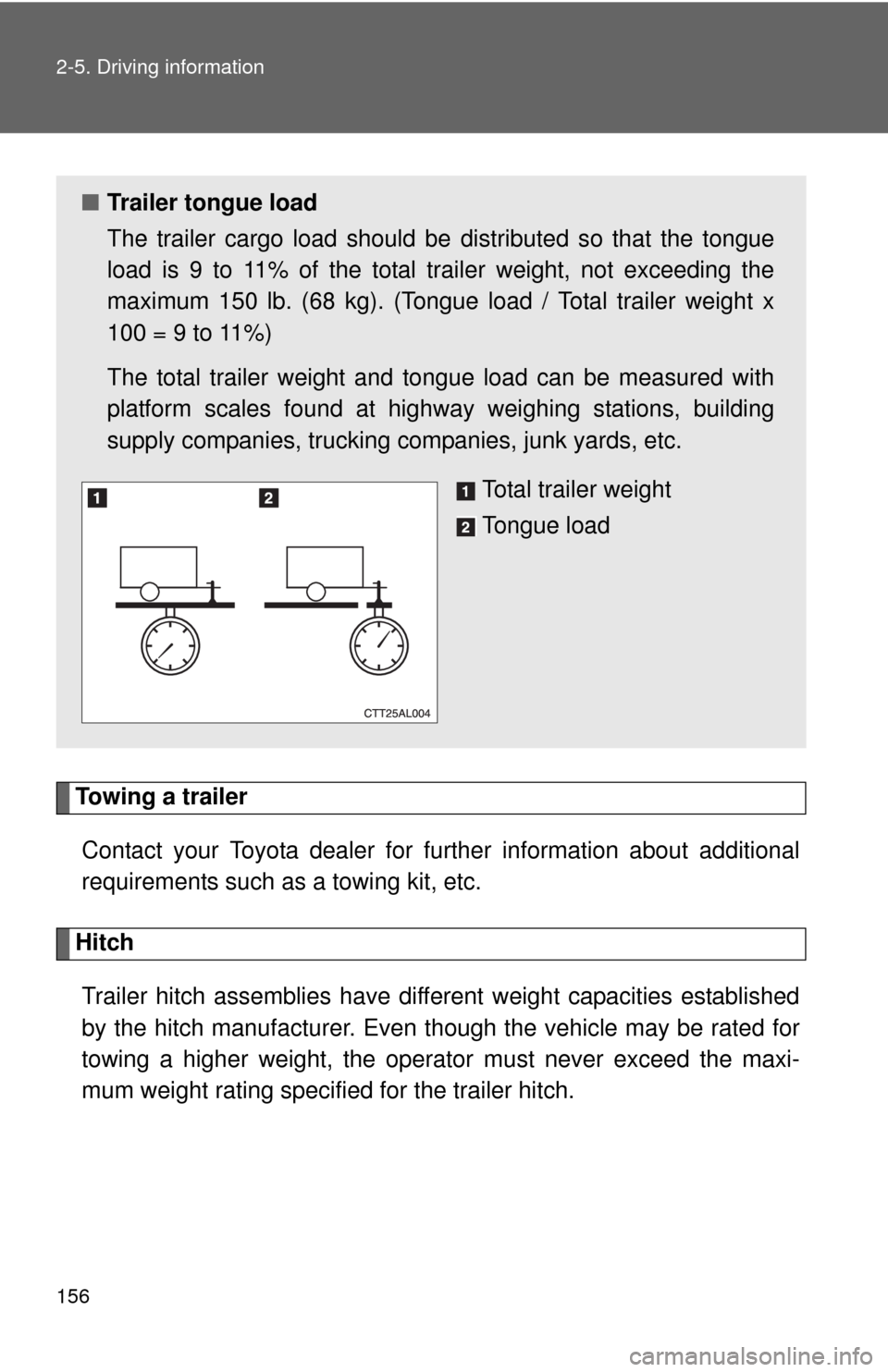
156 2-5. Driving information
Towing a trailer
Contact your Toyota dealer for further information about additional
requirements such as a towing kit, etc.
Hitch
Trailer hitch assemblies have different weight capacities established
by the hitch manufacturer. Even though the vehicle may be rated for
towing a higher weight, the operator must never exceed the maxi-
mum weight rating specified for the trailer hitch.
■Trailer tongue load
The trailer cargo load should be distributed so that the tongue
load is 9 to 11% of the total trailer weight, not exceeding the
maximum 150 lb. (68 kg). (Tongue load / Total trailer weight x
100 = 9 to 11%)
The total trailer weight and tongue load can be measured with
platform scales found at highway weighing stations, building
supply companies, trucking companies, junk yards, etc.
Total trailer weight
Tongue load
Page 157 of 448

157 2-5. Driving information
2
When driving
■Before towing
●Ensure that your vehicle’s tires are properly inflated. (P. 317)
●Trailer tires should be inflated according to the trailer manufacturer's rec-
ommendation.
●All trailer lights must work in order to be legal.
●Confirm all lights work each time you connect them.
●Check that your vehicle remains level when a loaded or unloaded trailer
is hitched. Do not drive if the vehicle is not level, and check for improper
tongue load, overloading, worn suspension, or other possible causes.
●Make sure the trailer cargo is securely loaded.
●Check that your rear view mirrors conform to any federal, state/provincial
or local regulations. If they do not, install rear view mirrors appropriate for
towing purposes.
■Break-in schedule
Toyota recommends that you do not use a new vehicle or a vehicle with any
new power train components (engine, transmission, differential, wheel bear-
ings, etc.) to tow a trailer for the first 500 miles (800 km) of driving.
■Maintenance
●If you tow a trailer, your vehicle will require more frequent maintenance
due to the additional load. (See “Scheduled Maintenance Guide” or
“Owner's Manual Supplement”.)
●Retighten the fixing bolts of the towing ball and bracket after approxi-
mately 600 miles (1000 km) of trailer towing.
Page 158 of 448
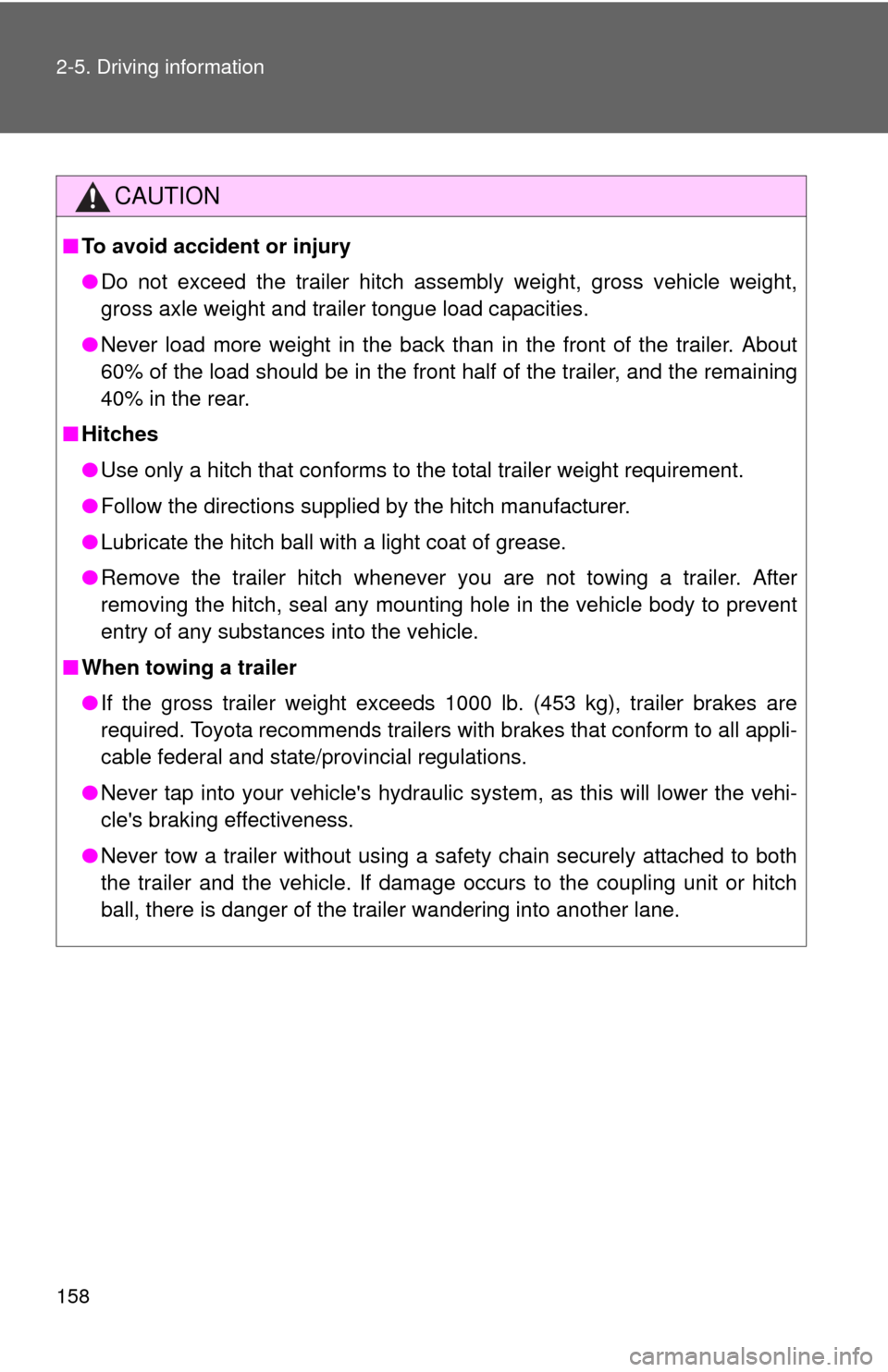
158 2-5. Driving information
CAUTION
■To avoid accident or injury
●Do not exceed the trailer hitch assembly weight, gross vehicle weight,
gross axle weight and trailer tongue load capacities.
●Never load more weight in the back than in the front of the trailer. About
60% of the load should be in the front half of the trailer, and the remaining
40% in the rear.
■Hitches
●Use only a hitch that conforms to the total trailer weight requirement.
●Follow the directions supplied by the hitch manufacturer.
●Lubricate the hitch ball with a light coat of grease.
●Remove the trailer hitch whenever you are not towing a trailer. After
removing the hitch, seal any mounting hole in the vehicle body to prevent
entry of any substances into the vehicle.
■When towing a trailer
●If the gross trailer weight exceeds 1000 lb. (453 kg), trailer brakes are
required. Toyota recommends trailers with brakes that conform to all appli-
cable federal and state/provincial regulations.
●Never tap into your vehicle's hydraulic system, as this will lower the vehi-
cle's braking effectiveness.
●Never tow a trailer without using a safety chain securely attached to both
the trailer and the vehicle. If damage occurs to the coupling unit or hitch
ball, there is danger of the trailer wandering into another lane.
Page 159 of 448

159 2-5. Driving information
2
When driving
Trailer towing tips
Your vehicle will handle differently when towing a trailer. The 3 main
causes of vehicle-trailer accidents are driver error, excessive speed
and improper trailer loading. Keep the following in mind when towing.
●Before starting out, check the trailer lights and the vehicle-trailer
connections. Recheck after driving a short distance.
●Practice turning, stopping and reversing with the trailer attached in
an area away from traffic until you become accustomed to the feel
of the vehicle.
NOTICE
■When installing a trailer hitch
●Use only the position recommended by your Toyota dealer. Do not install
the trailer hitch on the bumper; this may cause body damage.
●Do not use axle-mounted hitches, as they can cause damage to the axle
housing, wheel bearings, wheels or tires.
■Brakes
Toyota recommends trailers with brakes that conform to all applicable fed-
eral and state/provincial regulations.
■Safety chain
A safety chain must always be used between the towing vehicle and the
trailer. Leave sufficient slack in the chain for turns. The chain should cross
under the trailer tongue to prevent the tongue from dropping to the ground in
the case that it becomes damaged or separated. For the correct safety chain
installation procedure, ask your Toyota dealer.
■Do not directly splice trailer lights
Directly splicing trailer lights may damage your vehicle's electrical system
and cause a malfunction.